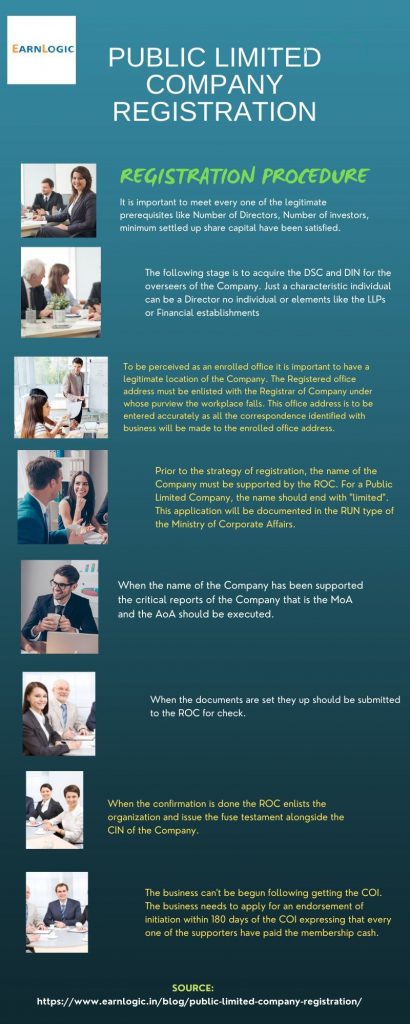A Public Limited Company registration in India is the best appropriate business form for business visionaries who are anticipating enormous scope business activities. To enroll a Public Limited Company in India there ought to be at minimum seven individuals and there is no restriction on the greatest number of individuals/investors for beginning a Public Limited Company.
A Public Limited Company in India partakes in every one of the advantages of a corporate element along with the components of Limited Liability. A public restricted organization gets recorded with the stock trade to raise capital from the overall population. Henceforth, the Public Limited Companies need to agree with different guidelines of the public authority and start a Public Limited Company.
A Public Limited Company that is enlisted under the arrangements that are recommended under the Companies Act, 2013. The individual from a Limited Company enlisted in India partakes in the components of Limited Liability and this kind of element is likewise permitted to raise capital from the general population by the issuance of offers.
Additionally, the standards and the guidelines of a Public Limited Company are more unbending and severe in contrast with the Private Limited Company. In any case, it is smarter to consolidate a Public Limited Company as it gives the advantages of a Private Limited Company with provisions like simple adaptability and responsibility for.
Requirements
Some different guidelines and guidelines are recommended under the Companies Act, 2013 for the development of a Public Limited Company in Inia. Here is an agenda one should know about while enlisting a Public Limited Company:
- Minimum 7 investors are needed to frame a Public Limited Company.
- A minimum 3 Directors is needed to shape a Public Limited Company.
- A base offer capital of Rs.5 lakh is required.
- DSC of one of the Directors is required when self-attested id copies and address proofs are submitted.
- DIN for the Directors is fundamental for Public limited company registration.
- Application is to be made for the determination of the Name of the Company.
- An application that contains the main object clause of the organization is made. This object clause will characterize the principle destinations of a Company after the consolidation.
- The application is submitted to the ROC alongside the fundamental records like MOA, AOA, a properly filled form DIR-12, Form INC 7, and Form INC – 22 is required.
- Payment of the enlistment charges that are recommended by the ROC.
- When the ROC has endorsed the organization ought to apply for the business beginning testament.
Documents required
Passport sized photos of all the Directors
DSC of Directors
DIN of Directors
Public limited company registration needs ID proofs of all the Directors like Aadhaar card, PAN
If the located office is on rent, then rent agreement
NOC from the landlord
If the located office is own property then property ownership documents.
Proofs for the registered office like electricity bill, water bill
AOA
MOA

Registration procedure
- It is important to meet every one of the legitimate prerequisites like Number of Directors, Number of investors, minimum settled up share capital have been satisfied. The further strides of registration will be finished just if this progression is finished.
- The following stage is to acquire the DSC and DIN for the overseers of the Company. Just a characteristic individual can be a Director no individual or elements like the LLPs or Financial establishments. It isn’t required for the Director to be the investor of the Company.
- To be perceived as an enrolled office it is important to have a legitimate location of the Company. The Registered office address must be enlisted with the Registrar of Company under whose purview the workplace falls. This office address is to be entered accurately as all the correspondence identified with business will be made to the enrolled office address. The registration charge will be reliant upon the approved capital of the organization.
- Prior to the strategy of registration, the name of the Company must be supported by the ROC. For a Public Limited Company, the name should end with “limited”. This application will be documented in the RUN type of the Ministry of Corporate Affairs. It is smarter to give a rundown of names in the request for inclination, in the event that a specific name isn’t accessible.
- When the name of the Company has been supported the critical reports of the Company that is the MoA and the AoA should be executed.
- When the documents are set they up should be submitted to the ROC for check.
- When the confirmation is done the ROC enlists the organization and issue the fuse testament alongside the CIN of the Company.
- The business can’t be begun following getting the COI. The business needs to apply for an endorsement of initiation within 180 days of the COI expressing that every one of the supporters have paid the membership cash.
Annual compliances for Public limited company
Annual General Meeting: Annual General Meeting must be held after Section 121(1) of the Companies Act, 2013. Form MGT-15 must be documented once the AGM has been directed.
Financial statements: The Financial Statements of the Company need to record according to Section 137 of the Companies Act, 2013, read with Rule 12(2) of the Companies (Accounts) Rule, 2014. The Financial assertion comprises of the monetary records, incomes articulations, Director’s assertion, Director’s report, Auditor’s report, and the joined monetary state, which means which is ready in XRBL (Extensible business detailing framework). This is recorded by means of Form AOC 4
Annual Return: This should be recorded after Section 92 of the Companies Act.2013 read with the Rule 11(1) of the Companies (Management and Administration) Rules, 2014. The Annual return contains the data about the chiefs and investors and is needed to be documented in Form MGT7 with the pertinent ROC.
Financial and Director’s Report: Adoption to the monetary and chief’s report is to be done in consonance with Section 173 of the Companies Act read with the Secretarial standard 1. The documenting is done by means of structure MGT 14.
Income Tax Returns: This is to be recorded with the Tax office in structure ITR 6 at the latest September 30th of the financial year
Secretarial Audit Report: Submission of the Secretarial report is a necessity under Section 204 of the Companies Act, 2013 read with Rule 9 of the Companies Rules, 2014. The secretarial report must be submitted just when the Company’s complete settled up capital is equivalent to or crosses Rs. 50 crores or the yearly turnover is equivalent to or surpasses INR 50 crores or the yearly turnover is surpassing Rs.250 crores. This documenting did by means of Form MR 3
Other compliances: These incorporate the standards and guidelines that are set somewhere near SEBI. The filed Companies need to agree with the guidelines of 2015.

